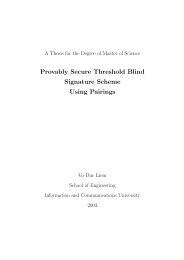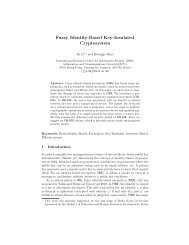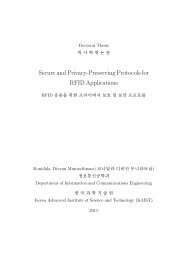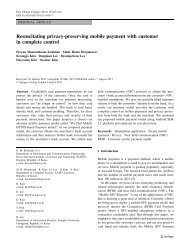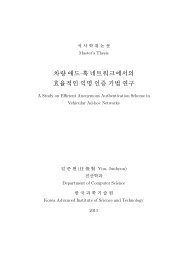RFID-enabled Extensible Authentication Framework and Its ...
RFID-enabled Extensible Authentication Framework and Its ...
RFID-enabled Extensible Authentication Framework and Its ...
You also want an ePaper? Increase the reach of your titles
YUMPU automatically turns print PDFs into web optimized ePapers that Google loves.
exchange. Moreover, there are some features they did not consider seri-<br />
ously when applying EAP to <strong>RFID</strong> systems. In the following items, we<br />
point out limitations of applying EAP into <strong>RFID</strong> systems.<br />
Limitation<br />
• Bulk-reading capability. In EAP, an authentication is performed<br />
with an EAP peer one-to-one, <strong>and</strong> each entity proceeds to the<br />
next authentication step synchronously, so-called “lock-step pro-<br />
tocol.” Unlike EAP, some <strong>RFID</strong> applications need bulk-reading<br />
capability. When a request is fired, a middleware should expect<br />
0 or more responses from tags <strong>and</strong> keep authentication state per<br />
tag with timer.<br />
• Traceability <strong>and</strong> privacy issues. An Identity (Type 1) ex-<br />
change sent in cleartext is optional in EAP, but it is “recom-<br />
mended to be used primarily.” On the other h<strong>and</strong>, in <strong>RFID</strong> sys-<br />
tems, it is better to design a method-specific identity exchange not<br />
to expose the identity of tag, especially in consumer application.<br />
Because obtaining the identity of a tag is the only goal in <strong>RFID</strong><br />
application, Identity Type should be used in the authentication<br />
method carefully.<br />
• Extremely low resources. Passive <strong>RFID</strong> tags have extremely<br />
low power because they induce current from incoming RF signals.<br />
Because outgoing RF communication consumes the large portion<br />
of available power, the shorter packet length is more suitable for<br />
<strong>RFID</strong> applications. EAP is designed to provide 1020 octets of<br />
MTU (Maximum Transmission Unit) <strong>and</strong> fragmentation. How-<br />
ever, the MTU size for <strong>RFID</strong> systems should be relatively small,<br />
<strong>and</strong> <strong>RFID</strong> cannot consider fragmentation.<br />
19



